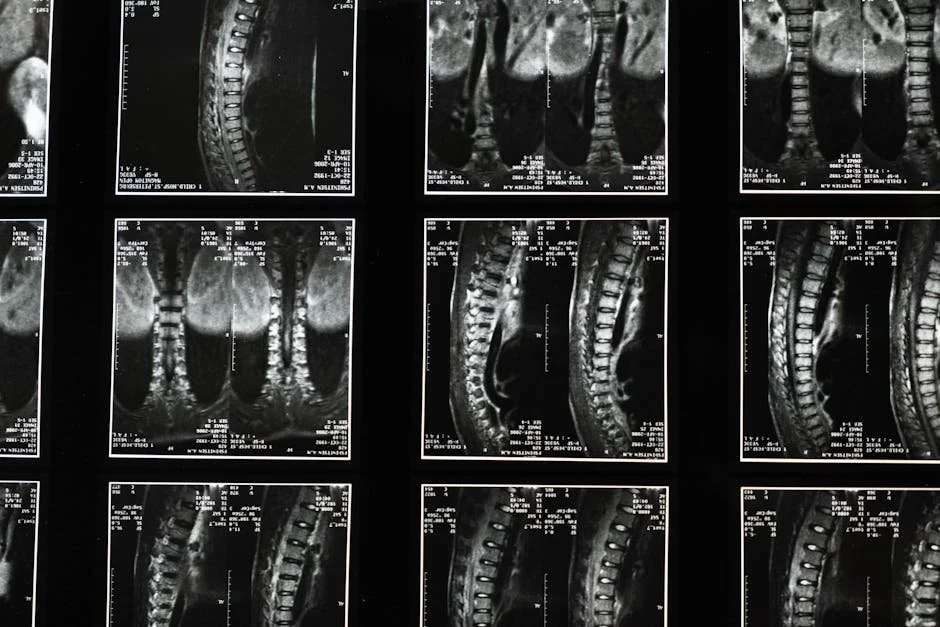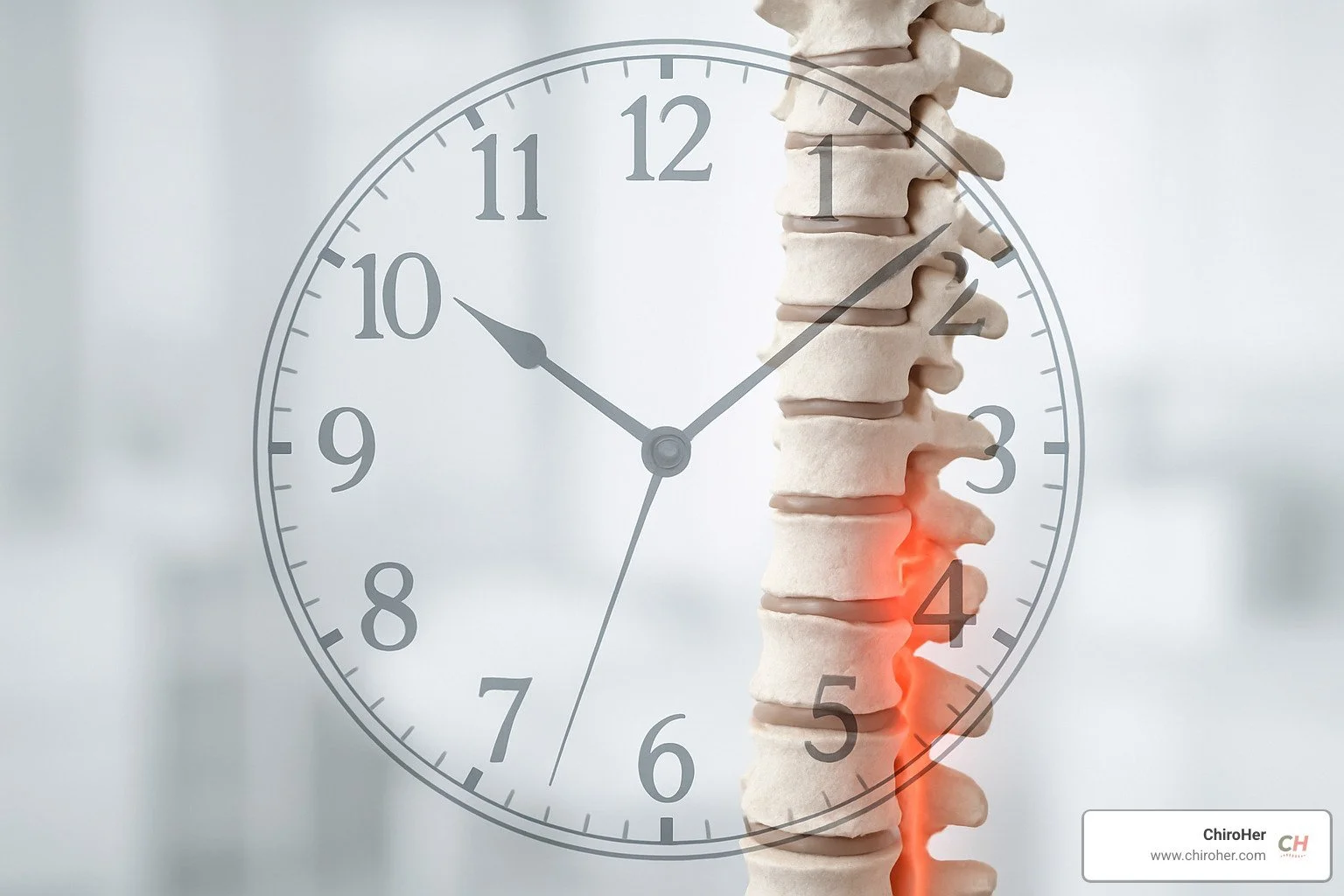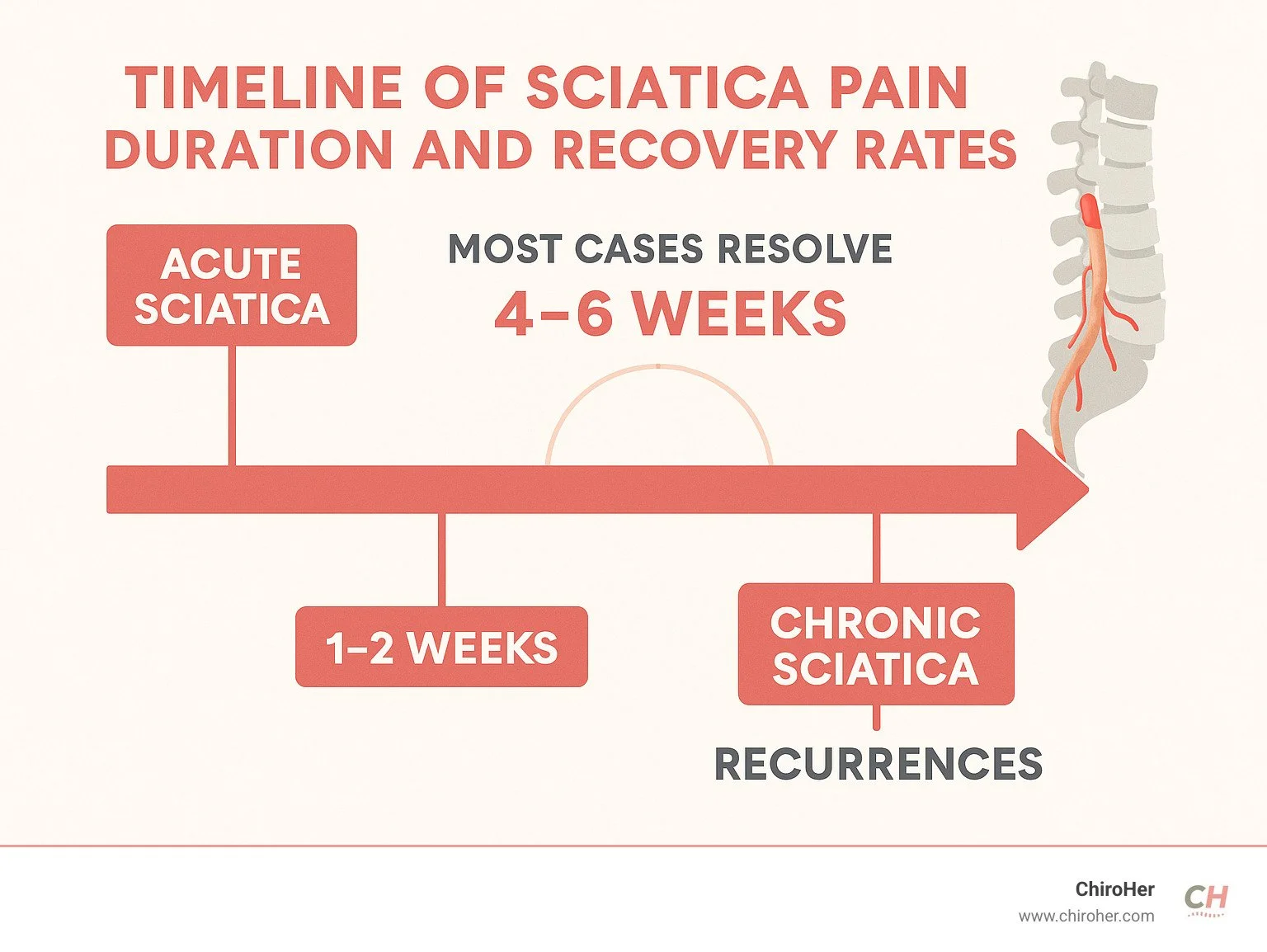Sciatica Survival Guide: How Long Does the Pain Stick Around?
How Long Does Sciatic Nerve Pain Last? Quick Answers Up Front
If you’re searching for how long does sciatic nerve pain last, here’s what you need to know — fast:
Pain Type Typical Duration Notes Acute Sciatica 4–6 weeks Most common, improves with simple self-care Chronic Sciatica More than 6 weeks (up to years) Less common, may need ongoing or advanced care Recurrence Flare-ups can return Prevention and active management are key Emergency Signs Immediate care needed Severe weakness, loss of bladder/bowel control
Most people see big improvement within 4–6 weeks — often without medical treatment.
About 3 out of 4 cases get better on their own in a month.
When sciatica pain sticks around longer than 6 weeks, it’s considered chronic and may need more help.
"Time, good posture, and gentle movement are the best medicine for most sciatica pain."
In this guide, you’ll get simple facts and clear advice to help you understand why sciatica pain can last days, weeks, or even months—and what you can do about it.
My name is Michelle Andrews, D.C. As the founder of ChiroHer, I’ve helped many Oklahoma City moms and professionals figure out how long does sciatic nerve pain last and recover with personalized, holistic care. With years of experience supporting moms (especially during pregnancy) and busy adults, I know how frustrating lingering nerve pain can be.
Sciatica 101: What It Is, Why It Happens
If you’ve ever felt a bolt of pain shoot down your leg, you’ve already met your sciatic nerve. This nerve is the longest and thickest in your body, running from the base of your spine through your hip and buttock, all the way down to your foot. When it gets irritated or squished—by anything from a slipped disc to a stubborn piriformis muscle—you get sciatica.
Common causes include:
Herniated (slipped) disc: The most frequent culprit—responsible for up to 90% of cases.
Spinal stenosis: Narrowing of the spinal canal, often with age.
Piriformis syndrome: A tight muscle in your buttock traps the nerve.
Pregnancy: Extra weight and shifting posture can compress the nerve.
Spondylolisthesis: When a vertebra slips forward onto the bone below it.
Back injuries or trauma: Sudden falls or accidents.
Risk factors: Age 30–50, sedentary lifestyle, obesity, smoking, and even stress can all play a role.
Common Triggers You Might Overlook
Poor sitting posture (slouching at your desk or on the couch)
Heavy or awkward lifting (hello, laundry baskets and toddlers)
Obesity (extra load on your spine)
Smoking (reduces blood flow to spinal discs)
Desk jobs with long hours of sitting
Want more back pain relief tips? Learn more here.
Typical Sciatica Symptoms from Hip to Toe
Sciatica isn’t just “back pain.” The classic symptoms include:
Sharp, shooting, or burning pain radiating from your lower back through your buttock and down the back of your leg (usually just one side)
Tingling or “pins and needles” in your leg or foot
Numbness in parts of your leg or foot
Muscle weakness (you may trip or struggle to lift your foot—so-called “foot drop”)
Rare but serious: trouble controlling your bladder or bowels (a medical emergency)
If your symptoms match this list, your sciatic nerve is likely the star of the show.
How Long Does Sciatic Nerve Pain Last?
Let’s get to what you’re really here for: how long does sciatic nerve pain last? The answer depends on a few factors, but here’s what the research and clinical experience tell us:
Most cases resolve within 4–6 weeks. In fact, 75% of people see improvement in just a month.
Acute sciatica (sudden onset, sharp pain): Typically lasts 1–2 weeks for the worst of it, with ongoing improvement over a few more weeks.
Chronic sciatica (persistent pain): Lasts more than 6 weeks, and sometimes months or years—though this is much less common (5–30% of cases).
Recurrences: Even after you feel better, flare-ups can return if you don’t manage risk factors.
Red-flag symptoms: Sudden weakness or loss of bladder/bowel control always requires immediate medical help.
Scientific research shows: By 6–12 months, people treated with or without surgery have similar outcomes—so patience and movement pay off.
For in-depth research on the usual sciatica timeline, check out Harvard’s overview.
Acute vs Chronic: How Long Does Sciatic Nerve Pain Last in Real Life?
Acute sciatica: Pain flares up suddenly, often after lifting or twisting. The worst is usually over in 1–2 weeks. Most people feel much better within 4–6 weeks.
Chronic sciatica: If pain lasts longer than 6 weeks, it’s considered chronic. In 5–30% of people, symptoms may persist for months to years—especially if the underlying cause (like a large herniated disc or spinal stenosis) isn’t addressed.
Healing phases:
Centralization phase: Pain retreats from the leg toward the back.
Desensitization phase: Tingling and numbness improve.
Rehabilitation phase: Strength and mobility come back.
Key Factors That Decide How Long Your Sciatica Sticks Around
Not all sciatica is created equal. Here’s what influences your recovery time:
Underlying cause: Herniated disc? Spinal stenosis? Piriformis muscle? Each has its own timeline.
Age: Sciatica strikes most often between 30–50 years old, but older adults may heal more slowly.
Activity level: Gentle movement speeds healing. Prolonged bed rest can actually make it worse.
Sleep quality: Poor sleep slows nerve repair.
Stress and emotional health: High stress can amplify pain.
Job demands: Physically demanding jobs may prolong recovery.
Smoking: Cuts blood flow to spinal nerves, slowing healing.
Cause Typical Recovery Time Mild herniated disc 4–6 weeks Large disc herniation 6–12 weeks, sometimes longer Spinal stenosis 3 months or more Piriformis syndrome 2–6 weeks with proper stretching Pregnancy-related Improves after delivery or with gentle care
Treatment and Prevention Strategies to Shorten Pain Timeline
Good news: Most cases of sciatica improve with simple steps you can start right now. Here’s how we help our clients (and what you can do at home):
Self-care basics:
Gentle movement: Short walks, easy stretching, and avoiding long periods of sitting are key.
Heat or ice: Heat relaxes tight muscles; ice can reduce inflammation.
Over-the-counter NSAIDs: Ibuprofen or naproxen may help, but check with your doctor.
Ergonomic fixes: Adjust your chair, desk, and car seat for better posture.
Professional care:
Chiropractic adjustments: Realigning the spine takes pressure off the nerve. Our ChiroHer team sees excellent results, especially with gentle, women-focused care.
Acupuncture: Shown to reduce pain and speed recovery for some people.
Physical therapy: Targeted exercises to strengthen your core, hips, and back.
Massage therapy: Can ease muscle tension and improve circulation.
Epidural steroid injections: For stubborn pain, your doctor may recommend these.
Surgery: Only for severe or unresponsive cases, or if you develop red-flag symptoms.
Lifestyle upgrades:
Lose excess weight
Quit smoking
Get regular, moderate exercise
Manage stress—yoga or mindfulness can help
Want to know more about exercise therapy for sciatica? Read the scientific research here.
Signs Your Sciatica Is Healing
How can you tell if you’re on the mend? Here are classic milestones:
Pain moves upward, away from your calf/foot and toward your buttock or back (“centralization”)
Fewer, less intense pain episodes
Improved ability to walk, stand, or do daily tasks
Less numbness or tingling
Stronger leg muscles
Sleeping better at night
Recovery is rarely a straight line—good days and bad days are normal. But if you’re ticking off more boxes each week, you’re headed in the right direction.
Red Flags: When to Call a Doctor
While most sciatica gets better on its own, call a healthcare professional right away if you notice:
Weakness that’s getting worse, especially if you can’t lift your foot (foot drop)
Loss of bladder or bowel control
Numbness in your groin or buttocks
Sciatica on both sides
Fever, chills, or unexplained weight loss (possible infection or tumor)
Pain that’s not improving after 6 weeks—or is getting worse
Learn more about serious back and sciatic pain here.
Keep It From Coming Back: Daily Habits That Protect Your Sciatic Nerve
Once you’re feeling better, keeping sciatica away is the next step. Our best prevention tips:
Use lumbar support when sitting—especially at work and in the car.
Take frequent breaks from sitting; stand up and stretch every 30–60 minutes.
Strengthen your core and glutes with regular exercises.
Practice safe lifting: Bend at the knees, not the waist. Keep objects close to your body.
Hydrate: Healthy discs need water.
Manage stress: Chronic tension tightens back muscles.
Maintain a healthy weight and avoid smoking.
Want to know how spinal adjustments support long-term back health? Read more here.
Fast Facts on How Long Sciatica Lasts (FAQs)
Does sciatica always go away on its own?
In most cases—yes. About 80–90% of people recover without surgery or advanced treatments. The key is patience, gentle movement, and keeping an eye on warning signs.
How can I tell my sciatica is improving?
Pain retreats toward your back (centralization)
Less numbness and tingling
Walking, standing, and moving get easier
You’re using less pain medication
Leg strength is coming back
Can sciatica become lifelong?
Chronic sciatica (lasting more than 1 year) happens in up to 30% of cases, but many people have only mild, occasional symptoms. Staying active, managing posture, and doing regular strengthening exercises keep those odds in your favor.
Final Takeaway
Sciatic nerve pain is common but rarely forever. Most people recover within 4–6 weeks, especially when they stay gently active and practice good habits. The best news? You have the power to influence your healing. Watch for red flags, but don’t panic—a little patience, movement, and maybe some help from a pro are usually all you need.
If you’re in Central Oklahoma and looking for compassionate, personalized care, ChiroHer’s award-winning chiropractic and acupuncture programs are designed to help you get back on your feet. We serve Oklahoma City, Yukon, Edmond, Nichols Hills, Del City, Mustang, and Moore with a gentle, holistic touch—especially for women and expecting moms.
For more on how expert chiropractic care can make a difference, read this guide.
Remember: Sciatica may slow you down, but with the right steps, it doesn’t have to stop you. We’re here to support you every step (and stretch) of the way.






